Southwood
I haven't attempted to copy the pages here but just inserted some of the raw material for publishing the book, as when I tried to scan the pages in directly the results were not very good. The results here look very like the pages of the book although the layout is different.
Introduction
The precise extent of the once wooded area from which Southwood in the town of Ramsgate takes its name is uncertain. Today, Southwood has much clearer definition in the local inhabitant's mental map as a predominantly residential area and as the home ground of Ramsgate football. It equates with the area of the former Southwood Farm and of Southwood House. Southwood's large, Victorian water tower is also one of Ramsgate's distinctive and prominent landmarks.
The Southwood neighbourhood occupies an area of about half a square kilometre, and consists predominantly of late nineteenth and early twentieth century houses. It sits on elevated ground one kilometre to the west of Ramsgate town centre and behind the more prestigious houses, cliff-top promenades and greens of the West Cliff area.
Southwood is adjoined to its north by Saint Lawrence, which marks the site of the earliest local settlement in Ramsgate. (Ramsgate itself developed first as a fishing hamlet at a natural dip in the chalk cliffs, and grew later principally as a resort). Once a tiny hamlet, which preceded but later developed around the parish church, Saint Lawrence, like Southwood, has since been assimilated into Ramsgate as the town developed. Both Southwood and Saint Lawrence retain some sense of identity, the latter reinforced by the dominant presence of its church.
Southwood actually evolved first as a separate hamlet in otherwise open farmland, and then became "built up" with housing around the turn of the century. The area cannot therefore be regarded as of such historic importance and general interest as, for example, Ramsgate Harbour or the concentrations of Regency housing around the town centre which more directly reflect the historic origins and development of the town. These aspects have been admirably recorded in a number of works (including, notably, "The book of Ramsgate" by Charles Busson)
I have very fond memories of Southwood and, as a small boy, frequently visited my grandparents' house there in Price's Avenue. These visits were often accompanied by visits to the beach and town or by leisurely days in the sunny back garden. Even at that early age, the attractive and characteristic qualities of the house and those in its immediate neighbourhood intrigued me and left a considerable impression. Largely unchanged today, the area retains a distinct sense of place, with an almost uncanny ability to evoke these pleasant recollections. More objectively, few would disagree that the neighbourhood offers a pleasant residential environment of some character.
This study has developed from my great interest in and affection for Southwood and, in particular, the houses in Price's Avenue. It aims to piece together a bit about the history and development of the roads, buildings and architecture which provide the area with its pleasant character. The study begins with the early nineteenth century, when most of Southwood was arable farmland.
I hope that the work will be of some local interest especially to those living in or having associations with Southwood and especially Price's Avenue neighbourhood, where I now live, and which, for me, will always be the "Heart" of Southwood.
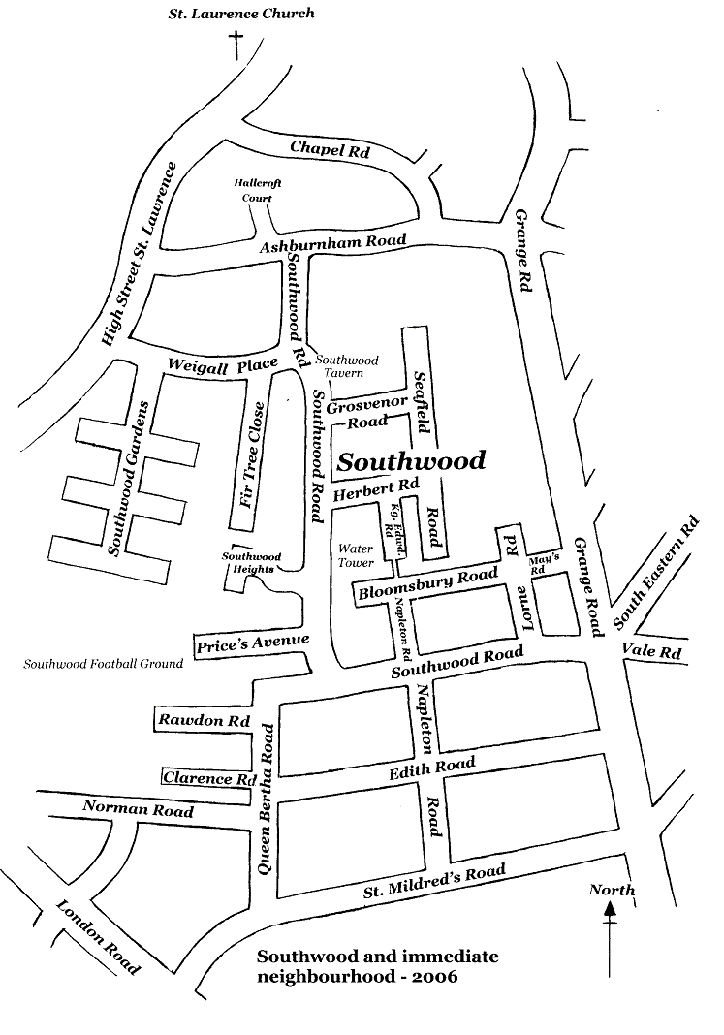
CHAPTER 1 - Southwood Farm
Price's Avenue is perhaps best locally known as the access road to the Ramsgate Football Ground, and for its somewhat quaint, attractive little dwelling, "Swiss Cottage". The Avenue consists of a short cul-de-sac situated about halfway along Southwood Road, which threads through the Southwood neighbourhood.
The land now occupied by Price's Avenue and much of built-up Southwood, was previously agricultural land, attached to Southwood Farm. Until 1805 the Farm was owned by George Osborne Sayer. The map below shows how Southwood looked at around this time. (The pecked square relates to area of the map on the preceding page)
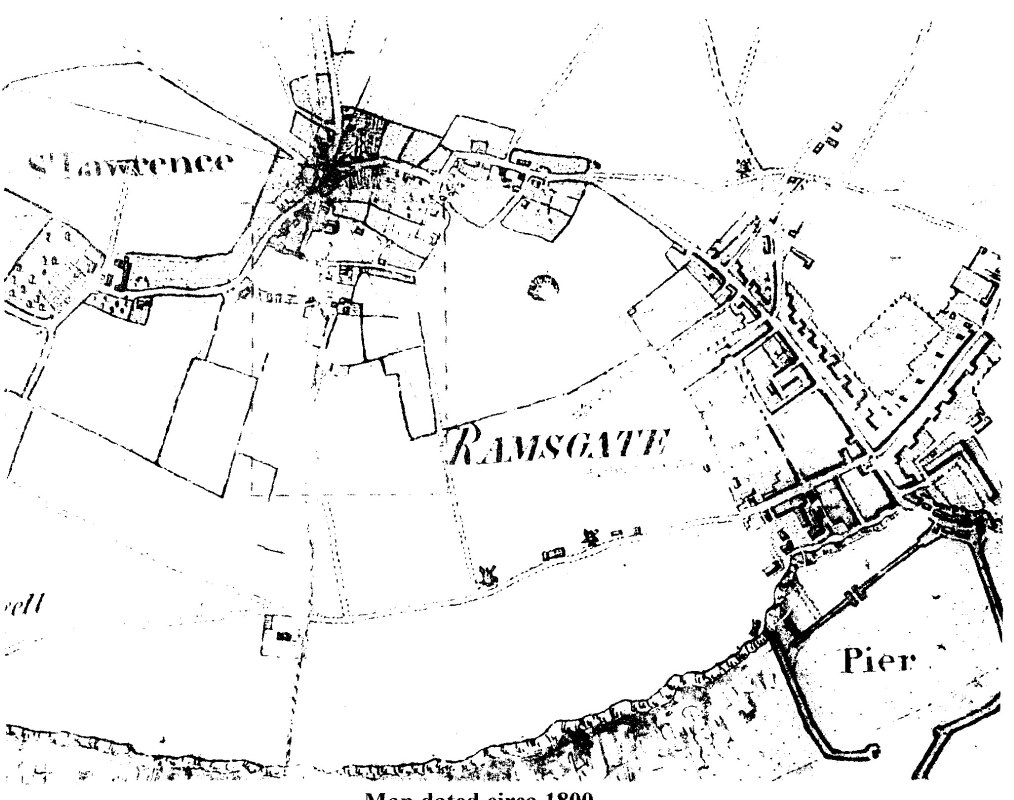
Map circa 1800 (Source ref 1)
After George Sayer died, Southwood Farm was inherited by his brother Richard. It later passed to Sarah Sayer (Richard Sayer's wife). The Farm buildings were situated behind the present Southwood Tavern, and the extent of the Farm is shown on the Plan dated Mid 19th Century. It is uncertain whether the Farm was actually known as South Wood Farm (as opposed to Southwood Farm) or whether this was simply an error on the auction plan!

View across Southwood Farm showing Southwood House - 1812
(Source ref 2)
The southern and western boundaries of the site which became Price's Avenue (then a small parcel in arable use) formed the outer extent of Southwood Farm. The land to the north of that parcel also once formed part of the Farm. However, in around 1835 a reservoir was built on it following formation of the Ramsgate Waterworks Company, (see Chapter 8). North of this stood Southwood House. (see Chapter 2)
To its south, the Price's Avenue land was abutted by a slightly larger arable enclosure. In about 1843 this was owned by Joseph Templeman; then owner and occupier of Southwood House. Around 1847 however, this land evidently belonged to J. A. Warre, and was probably attached to the now converted farm buildings called "The Homestead" (off London Road). In the middle of the century, the plot was developed with a large house (see Chapter 3). A path along its eastern boundary, which separated it from Southwood Farm, later became Queen Bertha Road.
The land to the west of the Price's Avenue site, then known as "Chilton Field", extended down to the present site of Nethercourt roundabout and was in the ownership of Benjamin Bushel and occupation of Thomas Mayhew. Nearby Nethercourt Farm was then in similar ownership and tenancy. Mr Mayhew (1798-1897) managed the Nethercourt Farm business on behalf of his uncle. Part of the land later became Southwood Football Ground, (See Chapter 7)
Southwood Farm Sold
Sarah Sayer died in around May 1847, having willed that (at least part of) the farm be shared equally between her son George Sayer and another party upon trust that their part of the land be sold at auction as considered expedient by their trustees. The Farm was auctioned that same year at the Albion Hotel, Ramsgate.
The farmland was divided into seven separate lots presumably to maximise its sale value as building land. The parcel of land which was to become Price's Avenue was sold as a separate lot (Lot 3). Just prior to sale, "Lot 3" was in the occupation of Mr. Bailey (a yearly tenant). It was already separately enclosed; then being surrounded on three sides by land in different ownerships, and bounded to its east by the track which later became Southwood Road.
Lot 3 was purchased for a price of £400. The details of sale note that it was believed to be brick earth, and that one acre of it had already been sold for £300. Available records indicate that a purchaser named "Witherden" bought Lots 1 - 3. After its sale, Lot 3 was worked as a brick field
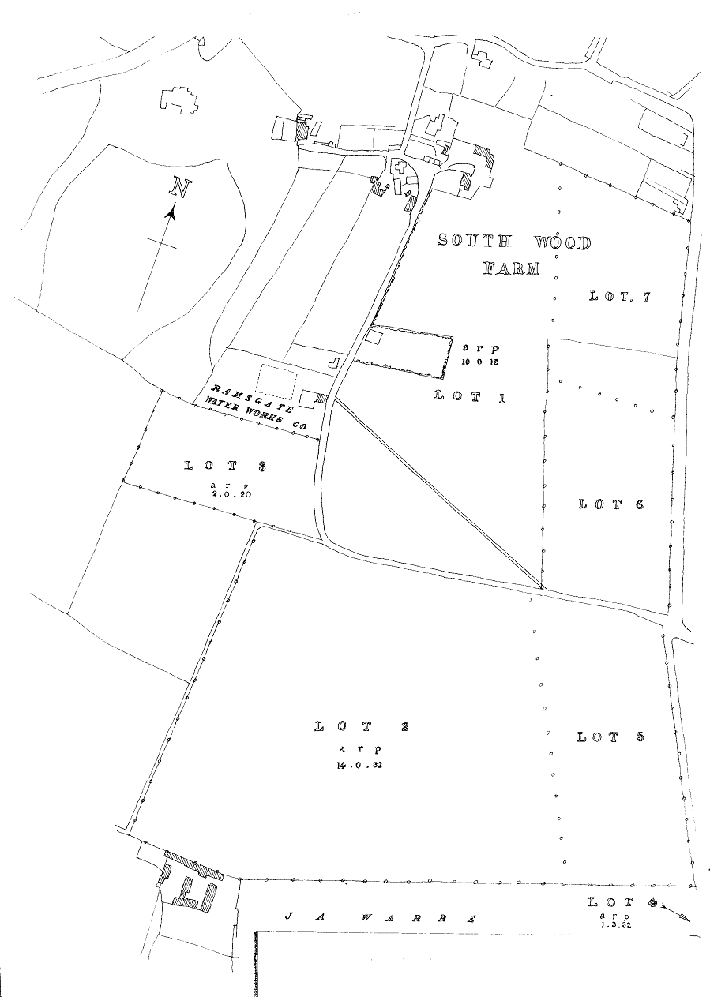
Mid 19th Century Plan showing Auction Lots Of Land At South Wood Farm.
Source ref 3
The next three Chapters look at some of the more distinguished and notable houses that pre-date much of built-up Southwood.
CHAPTER 2 - Southwood House
The area now occupied by Southwood Gardens previously formed the site and gardens of Southwood House. This house was indisputably the most famous and largest residence in Southwood.
Southwood House was built by a Captain Cotton who acquired the site, then occupied by two small cottages, and much of the land around it, in 1720. The house was sold to a Captain Burns who added the left wing and promptly sold it on to a Peter Burgess (one of the first elected commissioners for Ramsgate). Improvements were made with successive owners and the house became very sizeable.
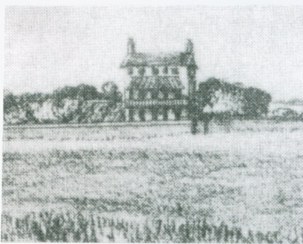
An advertisement of 1795 described Southwood House as being "Most desirable in situation, commanding uninterrupted views of the Downs and coasts of France, and the whole encircled with lofty brick walling and fit for the reception of a genteel family".
Southwood House 1812
(source ref 2)
It was at Southwood House that the Earl and Countess of Dunmore found a seaside residence. Their unhappy daughter, separated from the husband (the Duke of Sussex) to whom she believed herself legally married, joined them in Thanet at a house (since demolished) on the Ramsgate cliffs. The "Baroness D'Ameland", as she was called, was given her royal title by the sympathetic inhabitants of Ramsgate, though the King steadfastly refused to acknowledge her as the Duchess Of Sussex. The Countess of Dunmore died at Southwood House, and her tomb, together with that of her daughter and her two children is in St Lawrence Churchyard.
The tithe map of 1843 shows the house was then owned and occupied by Joseph Templeman. The House was subsequently purchased by the Dowager Countess of Ashburnham, daughter of the Duke of Northumberland, who died in 1865. Ashburnham Road in Southwood is named after her.
In August 1880 Southwood House was bought by Henry and Rose Weigall , and it was to remain the home of the Weigalls for the next forty years. The house was later demolished and redeveloped with the housing at Southwood Gardens (Chapter 11).
Rose Weigall's life is recorded through the recollections of friends and correspondence in "Lady Rose Weigall" by her daughter, Rachel Weigall (published 1923). As a notable inhabitant of Southwood, any study of its history would be incomplete without reference to her busy, influential and philanthropic life
The two pictures below are from the collection of Terry Wheeler Editor of About Ramsgate magazine for The Ramsgate Society, who is very helpful and generous in providing material for my publications. (Michael)
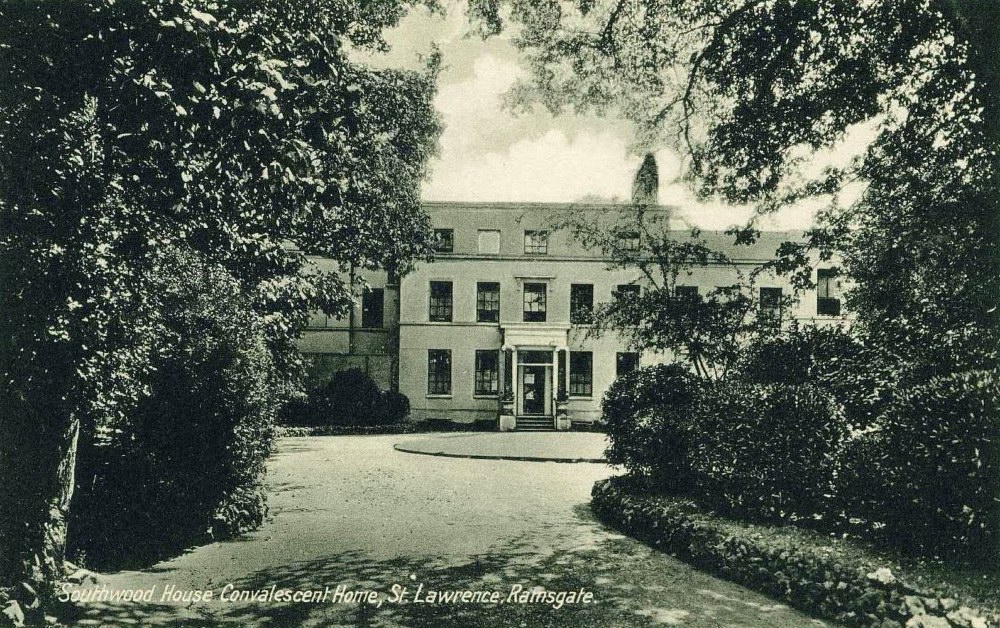
The front of Southwood House during World War One
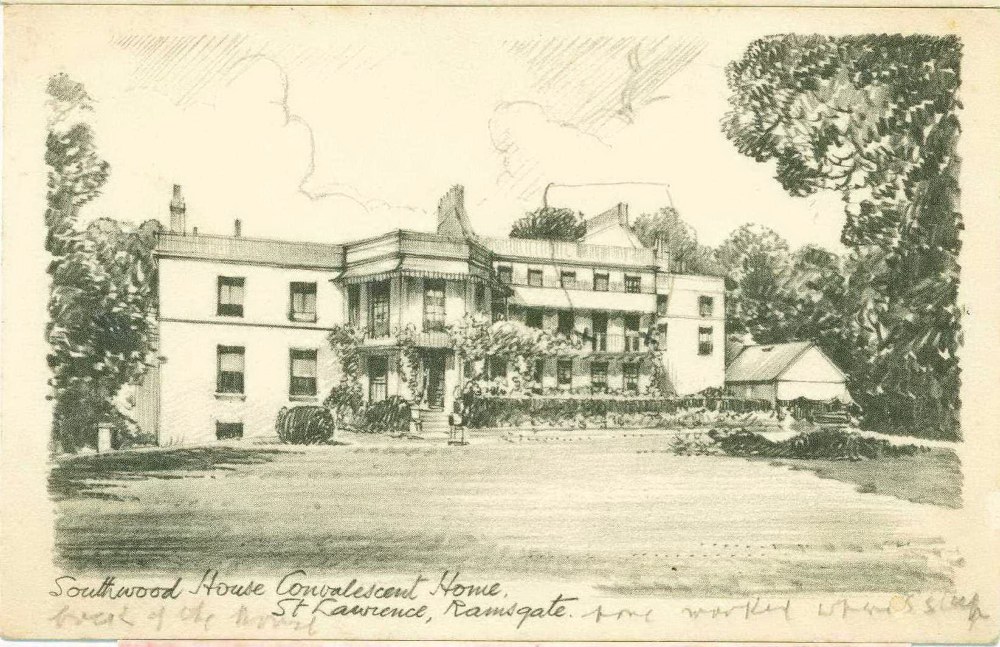
The back of Southwood House, Lady Rose Weigall allowed the house to be used as a convalescent home during World War One.
Biographical Note
Steve Moore was born in Hastings in 1956. At the age of three he moved with his parents to live in Newington Road, Ramsgate. Steve is married to Margaret, and they have a daughter, Shelley, Louise. He works as a planning officer for the local council. In his spare time Steve plays classical guitar and enjoys listening to music, admiring in particular the work of the Dutch guitarist Jan Akkerman.
PUBLISHERS NOTE
I have had considerable pleasure this week publishing Steve Moore's book and found that nearly all of the information contained in it was completely new to me. I find Ramsgate's diverse and attractive architecture of great interest, and have to admit that of our quiet residential areas often equally pleasing as that of our famous buildings. 07.03.07